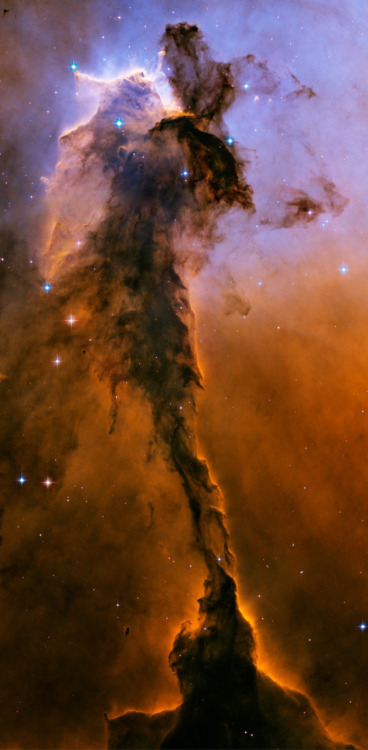The Fairy of Eagle Nebula, Ten light years tall and spewing radiation much hotter than fire. The Greater Eagle Nebula, M16, is an evaportting shell of gas and dust inside of which is a spectacular star nursey.
My daughter Erin posts NASA photos regularly on her blog, Thought and Memory, and I find myself dazzled and amazed by their beauty and scope. All our mythology and religious dogma seems pale in comparison to these breathtaking glimpses of the cosmos. This particular one was discovered by a man named Jean Phillippe de Cheseaux in 1745. It is in the constellation Serpens (Serpent). It is 6,500 light years away from us. Our first images of it came from the Hubble telescope in 1995, when it was named The Pillars of Creation.
Since light travels 186,000 miles a second, a light year is 5.88 trillion miles. So this beautful Nebula is 39,000 trillion miles away from us and yet we can see it. Or so we think. It is 9.5 light years tall, 1 to 2 million years old and a nursery to 460 stars whose luminosity is 1 million times that of our sun.
The columns that look like stalagmites are full of interstellar hydrogen gas and dust and they act as incubators of new stars. Inside the columns and on their surface are knots of denser gas called EGGs, or Evaporaating Gaseous Globules. Someone had a good time with that. This is where the stars are being formed, as we speak; maybe. Because there is some evidence that the Pillars of Creation may have been destroyed in a supernova explosion 6,000 years ago. If so, the new shape of the pillars will take another 500 years to reach us.
How we know or surmise all of these events is quite naturally beyond the scope of my education. Apart from the Hubble telescope and its pictures, it is incomprehensible to me. But those images have been the source of great awe and wonder.
They cause me to think how insignificant we are, but also how easily the cosmos and mother nature can replace our efforts here with a new model, if we fail to right our planet.
